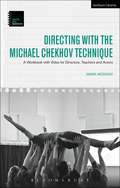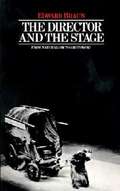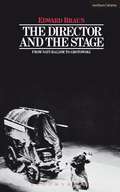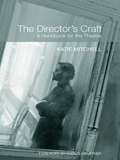- Table View
- List View
Directing Shakespeare in America: Historical Perspectives
by Charles NeyThis unique and comprehensive study reviews the practice of leading American directors of Shakespeare from the late nineteenth to the end of the twentieth century. Charles Ney examines rehearsal and production records, as well as evidence from diaries, letters, autobiographies, reviews and photographs to consider each director's point of view when approaching Shakespeare and the differing directorial tools and techniques employed in significant productions in their careers. Directors covered include Augustin Daly, David Belasco, Arthur Hopkins, Orson Welles, Margaret Webster, B. Iden Payne, Angus Bowmer, Craig Noel, Jack O'Brien, Tyronne Guthrie, John Houseman, Allen Fletcher, Michael Kahn, Gerald Freedman, Joseph Papp, Stuart Vaughan, A. J. Antoon, JoAnne Akalaitis, Paul Barry, Tina Packer, Barbara Gaines, William Ball, Liviu Ciulei, Garland Wright, Mark Lamos, Ellis Rabb and Julie Taymor. Directing Shakespeare in America: Historical Perspectives offers readers an understanding of the context from which contemporary practitioners operate, the aesthetic philosophies to which they subscribe and a description of their rehearsal methods.
Directing Shakespeare in America: Current Practices
by Charles NeyIn this first substantive study of directing Shakespeare in the USA, Charles Ney compares and contrasts directors working at major companies across the country. Because of the complexities of directing Shakespeare for audiences today, a director's methods, values and biases are more readily perceptible in their work on Shakespeare than in more contemporary work. Directors disclose their interpretation of the text, their management of the various stages of production, how they go about supervising rehearsals and share tactics. This book will be useful to students wanting to develop skills, practitioners who want to learn from what other directors are doing, and scholars and students studying production practice and performance.
Directing Shakespeare in America: Historical Perspectives
by Charles NeyThis unique and comprehensive study reviews the practice of leading American directors of Shakespeare from the late nineteenth to the end of the twentieth century. Charles Ney examines rehearsal and production records, as well as evidence from diaries, letters, autobiographies, reviews and photographs to consider each director's point of view when approaching Shakespeare and the differing directorial tools and techniques employed in significant productions in their careers. Directors covered include Augustin Daly, David Belasco, Arthur Hopkins, Orson Welles, Margaret Webster, B. Iden Payne, Angus Bowmer, Craig Noel, Jack O'Brien, Tyronne Guthrie, John Houseman, Allen Fletcher, Michael Kahn, Gerald Freedman, Joseph Papp, Stuart Vaughan, A. J. Antoon, JoAnne Akalaitis, Paul Barry, Tina Packer, Barbara Gaines, William Ball, Liviu Ciulei, Garland Wright, Mark Lamos, Ellis Rabb and Julie Taymor. Directing Shakespeare in America: Historical Perspectives offers readers an understanding of the context from which contemporary practitioners operate, the aesthetic philosophies to which they subscribe and a description of their rehearsal methods.
Directing the Decades: Lessons from Fifty Years of Becoming a Director
by Sue DunderdaleDirecting the Decades is an examination of the development of theatre in the UK since the revolution of the 1950s until the present day, viewed through the individual progress of a female director from a working-class background. In this book, theatre history and lessons on directing are interwoven: the history is presented decade by decade, examining particular productions. Each historical theatre chapter is followed by a method chapter examining directorial influences and techniques predominant in each decade, as well as examining the working experience of the author in that decade. The book also includes practical advice on the directing process, including exercises, plans for rehearsals, and camera plans. Sue Dunderdale offers a unique perspective on the evolution of theatre directing in the UK, and her work, which served as the foundation of the creation of the Theatre Lab and Directing program at RADA, continues to influence working directors today. Directing the Decades will be of interest to students and practitioners of theatre directing, acting, and theatre history, and to theatregoers with a consciousness of class and how it impacts on our lives. The book also offers access to online transcripts of interviews with 16 practitioners, including Rufus Norris, Michelle Terry, Kwame Kwei-Armah, Indhu Rubasingham, Nadia Latif, and Nadia Fall.
Directing the Decades: Lessons from Fifty Years of Becoming a Director
by Sue DunderdaleDirecting the Decades is an examination of the development of theatre in the UK since the revolution of the 1950s until the present day, viewed through the individual progress of a female director from a working-class background. In this book, theatre history and lessons on directing are interwoven: the history is presented decade by decade, examining particular productions. Each historical theatre chapter is followed by a method chapter examining directorial influences and techniques predominant in each decade, as well as examining the working experience of the author in that decade. The book also includes practical advice on the directing process, including exercises, plans for rehearsals, and camera plans. Sue Dunderdale offers a unique perspective on the evolution of theatre directing in the UK, and her work, which served as the foundation of the creation of the Theatre Lab and Directing program at RADA, continues to influence working directors today. Directing the Decades will be of interest to students and practitioners of theatre directing, acting, and theatre history, and to theatregoers with a consciousness of class and how it impacts on our lives. The book also offers access to online transcripts of interviews with 16 practitioners, including Rufus Norris, Michelle Terry, Kwame Kwei-Armah, Indhu Rubasingham, Nadia Latif, and Nadia Fall.
Directing with the Michael Chekhov Technique: A Workbook with Video for Directors, Teachers and Actors (Theatre Arts Workbooks)
by Mark MondayDirecting with the Michael Chekhov Technique explores the collaborative process between a play's director and the entire production team, making the journey of a production process cohesive using the Michael Chekhov Technique. No other technique provides the tools for both actor and director to communicate as clearly as does Michael Chekhov. Directing with the Michael Chekhov Technique is the first book to apply the insights of this celebrated technique to the realities of directing a theatrical production. The book chronicles the journey of a play, from conception through production, through the eyes of the director. Drawn from the author's rehearsal journals, logs and notes from each performance, the reader is shown how to arrive at a concept, create a concept statement and manage the realization of the play, utilizing specific techniques from Michael Chekhov to solve problems of acting and design. As with all books in the Theatre Arts Workbook series, Directing with the Michael Chekhov Technique will include online video exercises, "Teaching Tip†? boxes which streamline the book for teachers, and a useful Further Reading section.Directing with the Michael Chekhov Technique is the perfect guide to the production process for any director.
Directing with the Michael Chekhov Technique: A Workbook with Video for Directors, Teachers and Actors (Theatre Arts Workbooks)
by Mark MondayDirecting with the Michael Chekhov Technique explores the collaborative process between a play's director and the entire production team, making the journey of a production process cohesive using the Michael Chekhov Technique. No other technique provides the tools for both actor and director to communicate as clearly as does Michael Chekhov. Directing with the Michael Chekhov Technique is the first book to apply the insights of this celebrated technique to the realities of directing a theatrical production. The book chronicles the journey of a play, from conception through production, through the eyes of the director. Drawn from the author's rehearsal journals, logs and notes from each performance, the reader is shown how to arrive at a concept, create a concept statement and manage the realization of the play, utilizing specific techniques from Michael Chekhov to solve problems of acting and design. As with all books in the Theatre Arts Workbook series, Directing with the Michael Chekhov Technique will include online video exercises, “Teaching Tip” boxes which streamline the book for teachers, and a useful Further Reading section.Directing with the Michael Chekhov Technique is the perfect guide to the production process for any director.
Directing Young People in Theatre: A Guide to Staging Plays with Young Casts
by Samantha LaneThis book guides readers in taking a play from page to stage with young people. Advice from professional theatre directors, including Richard Eyre and Indu Rubasingham is combined with practical games and exercises to help both experienced and first-time directors create a play with young actors.
Directing Your Heart Out: Essays for Authenticity, Engagement, and Care in Theatre
by Tom DugdaleA ground-floor guide to the practice and philosophy of directing that is open to all, including newcomers to the field.Through a series of concise and engaging essays, Directing Your Heart Out will inspire the next generation of theatre directors by encouraging them to approach the craft through instinct, compassion and the uninhibited expression of their own voice and vision. Each of the book's essays deals with a core principle of directing, such as strategies for directing text; facilitating productive discussion in rehearsals; absorbing criticism; and maintaining a positive work environment. Taken together, they serve as an effective introduction to the fundamentals of directing, or as provocative supplementary readings alongside traditional directing textbooks. En route, it references:> more than 20 directors and choreographers> major contemporary ensembles such as The Wooster Group, SITI Company and Back to Back Theatre> key terminology, such as objective, action, obstacle, realism and absurdism > over 12 plays, including a close-reading of a scene from The SeagullEncouraging an approach to directing that is grounded in self-empowerment and set out accessibly, this book opens up directing to the first-time director or student from a range of backgrounds, as well as the seasoned professional, who will benefit from the many revisionary, fresh perspectives.
Directing Your Heart Out: Essays for Authenticity, Engagement, and Care in Theatre
by Tom DugdaleA ground-floor guide to the practice and philosophy of directing that is open to all, including newcomers to the field.Through a series of concise and engaging essays, Directing Your Heart Out will inspire the next generation of theatre directors by encouraging them to approach the craft through instinct, compassion and the uninhibited expression of their own voice and vision. Each of the book's essays deals with a core principle of directing, such as strategies for directing text; facilitating productive discussion in rehearsals; absorbing criticism; and maintaining a positive work environment. Taken together, they serve as an effective introduction to the fundamentals of directing, or as provocative supplementary readings alongside traditional directing textbooks. En route, it references:> more than 20 directors and choreographers> major contemporary ensembles such as The Wooster Group, SITI Company and Back to Back Theatre> key terminology, such as objective, action, obstacle, realism and absurdism > over 12 plays, including a close-reading of a scene from The SeagullEncouraging an approach to directing that is grounded in self-empowerment and set out accessibly, this book opens up directing to the first-time director or student from a range of backgrounds, as well as the seasoned professional, who will benefit from the many revisionary, fresh perspectives.
Direction: Readings in Theatre Practice (Readings in Theatre Practice)
by Simon ShepherdIs directing an art? Do directors need to be trained? What do directors actually do? These questions and more are answered in this accessibly written survey of the art of theatre direction. Its broad scope ranges across the theatres of both America and Europe, looking at practices from Stanislavski up to the present day.
Direction: Readings in Theatre Practice (Readings in Theatre Practice)
by Simon ShepherdIs directing an art? Do directors need to be trained? What do directors actually do? These questions and more are answered in this accessibly written survey of the art of theatre direction. Its broad scope ranges across the theatres of both America and Europe, looking at practices from Stanislavski up to the present day.
Directions for Directing: Theatre and Method
by Avra SidiropoulouDirections for Directing: Theatre and Method lays out contemporary concepts of directing practice and examines specific techniques of approaching scripts, actors, and the stage. Addressed to both young and experienced directors but also to the broader community of theatre practitioners, scholars, and dedicated theatre goers, the book sheds light on the director’s multiplicity of roles throughout the life of a play – from the moment of its conception to opening night – and explores the director’s processes of inspiration, interpretation, communication, and leadership. From organizing auditions and making casting choices to decoding complex dramaturgical texts and motivating actors, Directions for Directing offers practical advice and features detailed workbook sections on how to navigate such a fascinating discipline. A companion website explores the work of international practitioners of different backgrounds who operate within various institutions, companies, and budgets, providing readers with a wide range of perspectives and methodologies.
Directions for Directing: Theatre and Method
by Avra SidiropoulouDirections for Directing: Theatre and Method lays out contemporary concepts of directing practice and examines specific techniques of approaching scripts, actors, and the stage. Addressed to both young and experienced directors but also to the broader community of theatre practitioners, scholars, and dedicated theatre goers, the book sheds light on the director’s multiplicity of roles throughout the life of a play – from the moment of its conception to opening night – and explores the director’s processes of inspiration, interpretation, communication, and leadership. From organizing auditions and making casting choices to decoding complex dramaturgical texts and motivating actors, Directions for Directing offers practical advice and features detailed workbook sections on how to navigate such a fascinating discipline. A companion website explores the work of international practitioners of different backgrounds who operate within various institutions, companies, and budgets, providing readers with a wide range of perspectives and methodologies.
The Director and Directing: Craft, Process and Aesthetic in Contemporary Theatre
by Adam J. LedgerThis book critically assesses the artistry of contemporary directors. Its discussion includes the work of Declan Donnellan, Thomas Ostermeier, Deborah Warner, Simon Stone and Krzysztof Warlikowski. Alongside the work of wider theorists (Patrice Pavis and Erika Fischer-Lichte), it uses neuroaesthetic theory (Semir Zeki) and cognitive and creative process models to offer an original means to discuss the performance event, emotion, brain structures and concepts, and the actor’s body in performance. It offers first-hand observation of rehearsals led by Katie Mitchell, Ivo van Hove, Carrie Cracknell and the Steppenwolf Theatre. It also explores devising in relation to the work of Simon McBurney and contemporary groups, and scenography in relation to the work of Dmitry Krymov, Robert Wilson and Robert Lepage. The Director and Directing argues that the director creates a type of knowledge, ‘reward’ and ‘resonant experience’ (G. Gabrielle Starr) through instinctive and expert choices.
Director And The Stage: From Naturalism To Grotowski (PDF)
by Edward BraunBeginning with the triple impulses of Naturalism, symbolism and the grotesque, the bulk of the book concentrates on the most famous directors of this century - Stanislavski, Reinhardt, Graig, Meyerhold, Piscator, Brecht, Artuaud and Grotowski. Braun's guide is more practical than theoretical, delineating how each director changed the tradition that came before him.
The Director as Collaborator
by Robert KnopfThe Director as Collaborator teaches essential directing skills while emphasizing how directors and theater productions benefit from collaboration. Good collaboration occurs when the director shares responsibility for the artistic creation with the entire production team, including actors, designers, stage managers, and technical staff. Leadership does not preclude collaboration; in theater, these concepts can and should be complementary. Students will develop their abilities by directing short scenes and plays and by participating in group exercises. New to the second edition: updated interviews, exercises, forms, and appendices new chapter on technology including digital research, previsualization and drafting programs, and web-sharing sites new chapter on devised and ensemble-based works new chapter on immersive theater, including material and exercises on environmental staging and audience–performer interaction
The Director as Collaborator
by Robert KnopfThe Director as Collaborator teaches essential directing skills while emphasizing how directors and theater productions benefit from collaboration. Good collaboration occurs when the director shares responsibility for the artistic creation with the entire production team, including actors, designers, stage managers, and technical staff. Leadership does not preclude collaboration; in theater, these concepts can and should be complementary. Students will develop their abilities by directing short scenes and plays and by participating in group exercises. New to the second edition: updated interviews, exercises, forms, and appendices new chapter on technology including digital research, previsualization and drafting programs, and web-sharing sites new chapter on devised and ensemble-based works new chapter on immersive theater, including material and exercises on environmental staging and audience–performer interaction
A Director Prepares: Seven Essays on Art and Theatre
by Anne BogartA Director Prepares is a thought-provoking examination of the challenges of making theatre. In it, Anne Bogart speaks candidly and with wisdom of the courage required to create 'art with great presence'. Each chapter tackles one of the seven major areas Bogart has identified as both potential partner and potential obstacle to art-making. They are Violence; Memory; Terror; Eroticism; Stereotype; Embarrassment; and Resistance. Each one can be used to generate extraordinary creative energy, if we know how to use it. A Director Prepares offers every practitioner an extraordinary insight into the creative process. It is a handbook, Bible and manifesto, all in one. No other book on the art of theatre comes even close to offering this much understanding, experience and inspiration.
A Director Prepares: Seven Essays on Art and Theatre
by Anne BogartA Director Prepares is a thought-provoking examination of the challenges of making theatre. In it, Anne Bogart speaks candidly and with wisdom of the courage required to create 'art with great presence'. Each chapter tackles one of the seven major areas Bogart has identified as both potential partner and potential obstacle to art-making. They are Violence; Memory; Terror; Eroticism; Stereotype; Embarrassment; and Resistance. Each one can be used to generate extraordinary creative energy, if we know how to use it. A Director Prepares offers every practitioner an extraordinary insight into the creative process. It is a handbook, Bible and manifesto, all in one. No other book on the art of theatre comes even close to offering this much understanding, experience and inspiration.
The Director & The Stage: From Naturalism to Grotowski (Performance Books)
by Edward BraunBeginning with the triple impulses of Naturalism, symbolism and the grotesque, the bulk of the book concentrates on the most famous directors of this century - Stanislavski, Reinhardt, Graig, Meyerhold, Piscator, Brecht, Artuaud and Grotowski. Braun's guide is more practical than theoretical, delineating how each director changed the tradition that came before him.
The Director & The Stage: From Naturalism to Grotowski (Performance Books)
by Edward BraunBeginning with the triple impulses of Naturalism, symbolism and the grotesque, the bulk of the book concentrates on the most famous directors of this century - Stanislavski, Reinhardt, Graig, Meyerhold, Piscator, Brecht, Artuaud and Grotowski. Braun's guide is more practical than theoretical, delineating how each director changed the tradition that came before him.
Directors and the New Musical Drama: British and American Musical Theatre in the 1980s and 90s (Palgrave Studies in Theatre and Performance History)
by M. Lundskaer-NielsenThis is one of the first books to offer a rigorous analysis of the enormous changes in the musical theatre during the 1980s and 90s. In addition, it focuses on the contribution of well-known, serious theatre directors to the mainstream Musical Theatre and it is the first book to offer a dual Anglo-American perspective on this subject.
The Director's Craft: A Handbook for the Theatre (PDF)
by Katie MitchellThe Director’s Craft is a unique and completely indispensable step-by-step guide to directing for the stage. Written by one of the most adventurous and respected directors working today, this book will be an essential item in every student and practitioner’s kitbag. It provides detailed assistance with each aspect of the varied challenges facing all theatre directors, and does so with startling clarity. It will inspire everyone, from the beginner just starting out to the experienced practitioner looking to reinvigorate their practice. Katie Mitchell shares and explains the key practical tools she uses to approach her work with both actors, production teams, and the text itself. She addresses topics such as: the ideas that underpin a play’s text preparing improvizations Twelve Golden Rules for working with actors managing the transition from rehearsal room to theatre analyzing your work after a run has ended. Each chapter concludes with a summary of its critical points, making this an ideal reference work for both directors and actors at any stage of their development.
The Director's Craft: A Handbook For The Theatre
by Katie MitchellThe Director’s Craft is a unique and completely indispensable step-by-step guide to directing for the stage. Written by one of the most adventurous and respected directors working today, this book will be an essential item in every student and practitioner’s kitbag. It provides detailed assistance with each aspect of the varied challenges facing all theatre directors, and does so with startling clarity. It will inspire everyone, from the beginner just starting out to the experienced practitioner looking to reinvigorate their practice. Katie Mitchell shares and explains the key practical tools she uses to approach her work with both actors, production teams, and the text itself. She addresses topics such as: the ideas that underpin a play’s text preparing improvizations Twelve Golden Rules for working with actors managing the transition from rehearsal room to theatre analyzing your work after a run has ended. Each chapter concludes with a summary of its critical points, making this an ideal reference work for both directors and actors at any stage of their development.
















